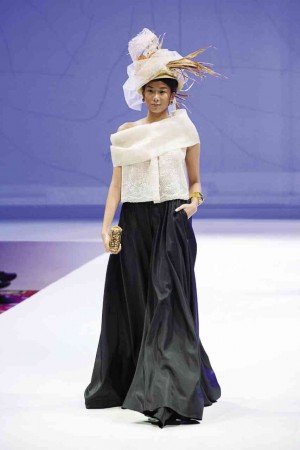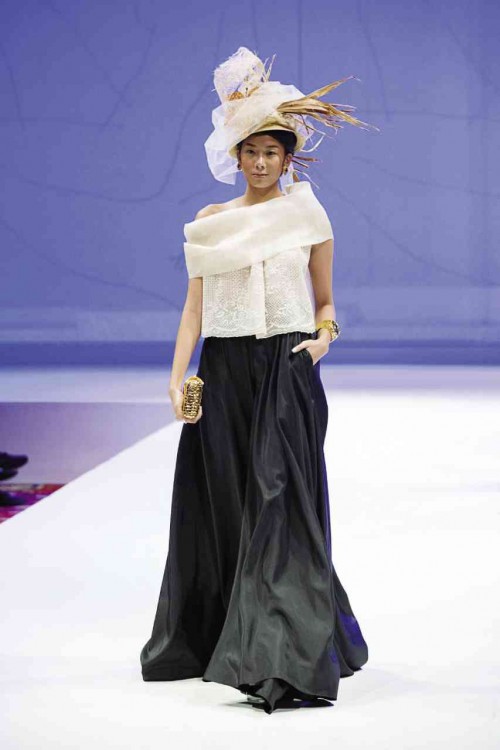MANILA, Philippines—At least two generations of Filipino fashion designers went head-to-head last Sunday to prove that what they’ve been doing with the terno, they could also do with the maria clara.
It was an ambitious project: To bring together 32 of the country’s most influential fashion designers in one single show, with the goal of taking to the forefront of sartorial consciousness the maria clara costume, reimagined to suit contemporary tastes and needs.
On Nov. 30, Inquirer Lifestyle, with Hana Shampoo and Champion Infinity, staged the seventh edition of the “Face-Off” fashion series, “Masters and Millennials,” at the grand ballroom of Solaire Resort & Casino.
The concept of “Face-Off” is to pit fashion designers against one another in one friendly creative arena. “Masters and Millennials” upped the ante even further by not only setting up individual designers for an artistic tussle, but for at least two generations of them to outdo each other on the runway.
The “Masters” and “Millennials” categories were meant not only to signify each designer’s number of years in the fashion industry, but also to ascertain if the generational divide between these two groups would show how they differed in reinterpreting the maria clara.
This wasn’t the first time that at least a dozen fashion designers went head-to-head to one-up one another in a single show. But it surely was the first time that the generation gap was highlighted in a show’s theme.
Who wins? The audience decides—in private, just among themselves.
Glamour quotient
“Face-Off” is a brainchild of Inquirer Lifestyle editor Thelma Sioson San Juan, who wrote last week in explaining the event’s theme:
“Today, the socially visible Filipino woman wears Filipiniana at least once a year.
“Aside from the President’s annual state of the nation address (Sona) before a joint legislature, there are more and more occasions these days to don the maria clara and raise its glamour quotient.
“Since many competitions and social events revolve around the terno, we thought of focusing instead on the maria clara, which, if you think about it, is more practical to wear—it’s basically top and skirt… It also lends itself to contemporary reinvention.”
This year’s featured designers were:
Masters: Albert Andrada, Barba, JC Buendia, Auggie Cordero, Ito Curata, Rhett Eala, Cesar Gaupo, Oj Hofer, Rajo Laurel, Jojie Lloren, Loretto, Dennis Lustico, Efren Ocampo, Randy Ortiz, Philip Rodriguez, Mike de la Rosa, Cary Santiago and Lulu Tan Gan.
Millennials: Edwin Ao, Jerome Salaya Ang, Ivarluski Aseron, Pablo Cabahug, Louis Claparols, Eric de los Santos, Maureen Disini, Jun Escario, Sassa Jimenez, Francis Libiran, Yvonne Quisumbing, James Reyes, Vania Romoff and Joey Samson.
The director’s chair was also a virtual face-off between Robby Carmona, who helmed the “Millennials” segment, and Jackie Aquino, who directed the “Masters.”

Full house
It was a Sunday night, when even the most active of social butterflies usually opt to stay in. But it was full house in Solaire’s grand ballroom; some guests even came in varied permutations of the suggested dress code: “modern Filipino.”
Each designer was tasked to create three looks, the third to be worn by his/her muse, such that guests were treated to a grand sartorial feast, with over 100 looks, including capsule collections for the sponsors, in a show that lasted nearly two hours—an epic by fashion-show standards.
Compared to the terno, a European-inspired long dress with distinctive stiff, curved sleeves called “butterfly sleeves,” the classic maria clara is composed of the baro (top) with voluminous bell sleeves, a long saya (skirt), a panuelo (large kerchief usually wrapped around the shoulders), and a tapis, a piece of cloth wrapped around the waist.
It’s named after the heroine of Jose Rizal’s “Noli Me Tangere” and, as veteran designer Auggie Cordero opined, perhaps a bastardized version of a Hispanic dress during the Spanish occupation.
And it was indeed fascinating to see how the 32 designers tackled their brief. The generational divide was more apparent than expected, with the younger designers’ near-collective sensibilities contrasting starkly with their more senior counterparts.
While the so-called Masters largely went for dressier evening looks, proving that the maria clara can be just as elegant an alternative to the terno, the Millennials showed that it can be adapted even to streetwear; that if done right, it can be wearable and indeed be relevant to contemporary life. They proved that it can be youthful, playful, even sexy.
Instructional
The show was also instructional, that if designers could make a traditional costume using Filipino fabrics (piña and jusi), which some did, so could they with contemporary and technical materials. Fabric du jour was neoprene, typically used for scuba-diving wetsuits, and we saw it in more than a few looks, and not only from the Millennials.
In explaining his design concept, for instance, one of the Masters, Ito Curata, said: “Although the maria clara was considered then, as well as now, very stylish for formal occasions, I noticed that there were certain elements which today are no longer practical for the modern woman. For example, the bulky nature of the gown… Today, women who attend formal parties want a gown that does not restrict movement… Also, the modesty elements of some of the old designs are the antitheses of contemporary design and fit.”
Admittedly, some looks had the vaguest, most ambiguous reference to the maria clara, that at times we had to stretch our imagination, squint our eyes just a little, to see if it was there. At least two designers also sent out clothes that clearly showed they were versions not of the maria clara but of the terno; we had to wonder if they got the memo.
Save for such minor hiccups, “Face-Off 2014” looked to have achieved what it set out to do, and that’s to revive interest in the maria clara as an alternative to the terno as modern Filipiniana wear. It also proved that in the right hands, traditional Filipino costumes can be a wellspring of inspiration for appropriate and practical wear, not just for red-carpet events but for everyday life, as well.
Face-Off 2014 was staged with Hana Shampoo and Champion Infinity, in cooperation with O+USA, Solaire Resorts & Casino, and LOOK magazine.
Preparing the models backstage were Max Factor for makeup and Jing Monis Salon. Chuchie Ledesma of Maybelline New York also helped.
RELATED VIDEO









































